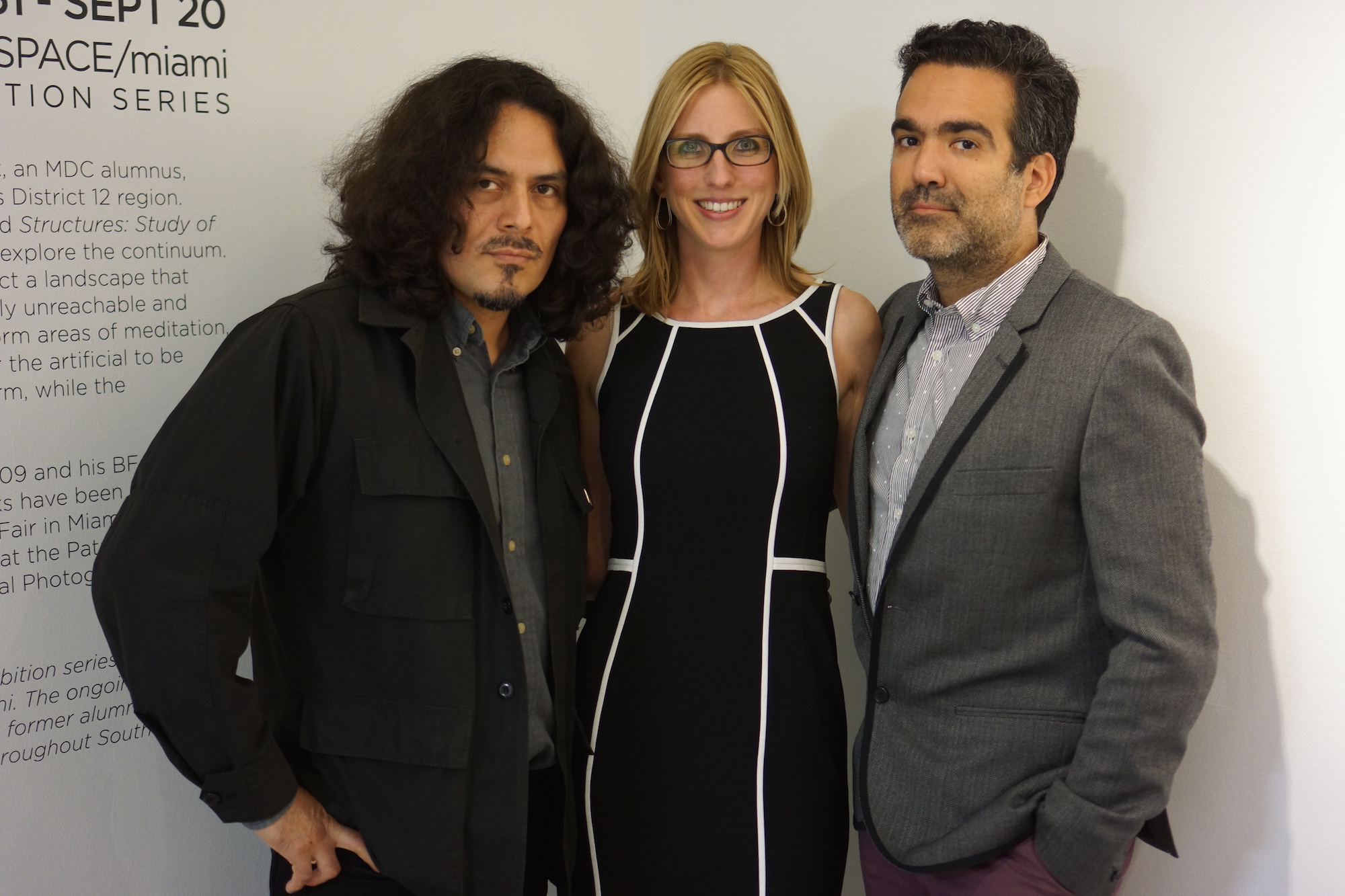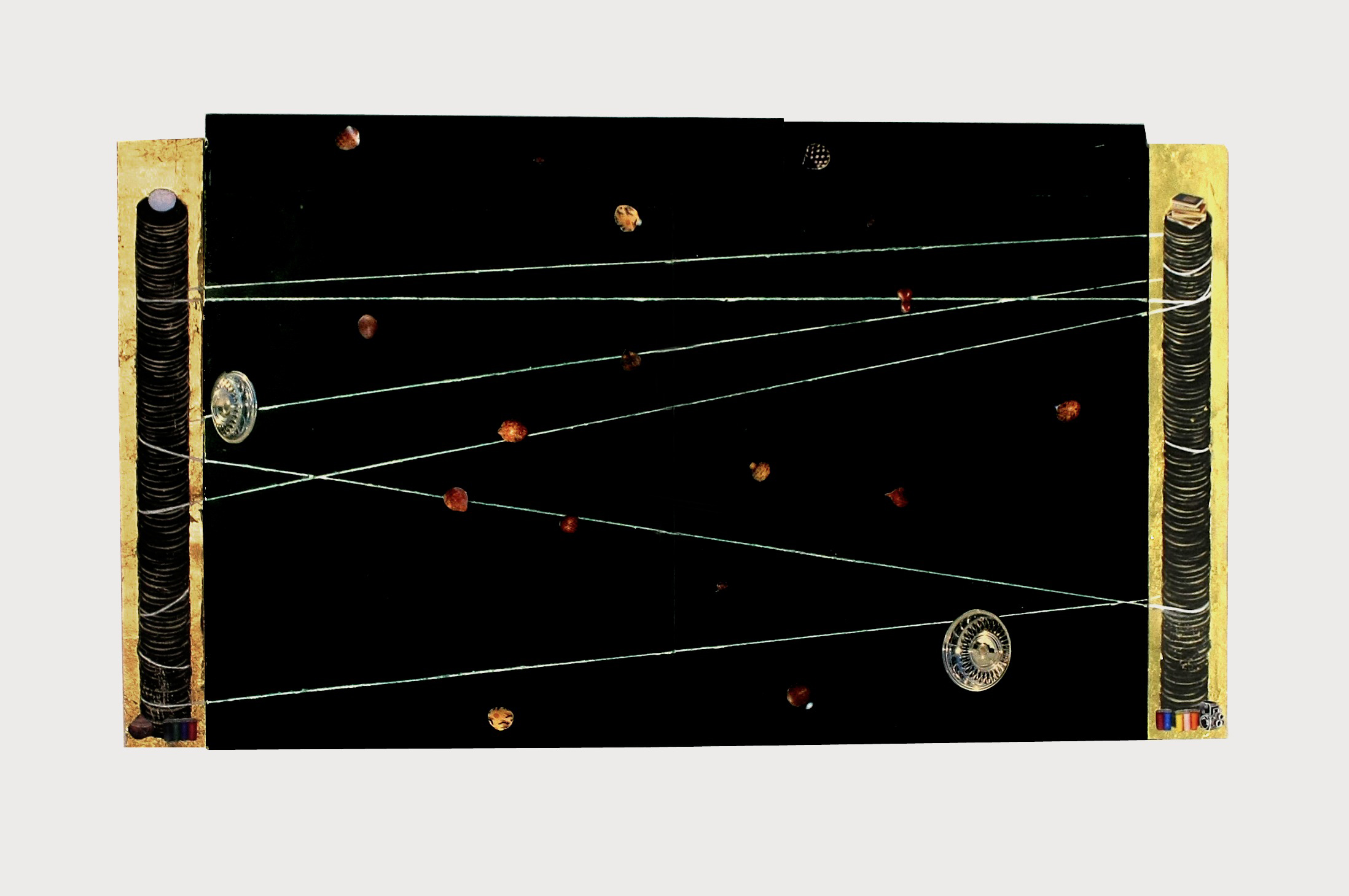
Artists aim to break down walls, build bridges with for-charity exhibition in Miami’s Freedom Tower
Photo: An artist talk with William Cordova and Luis Gispert at the MDC Museum of Art + Design.
There is a wonderful synergy to the small works that are hanging in Miami’s Freedom Tower, on an introductory wall to the galleries of the Museum of Art + Design at Miami Dade College. First off, the series of collages are a unique collaboration between William Cordova and Luis Gispert, two Miami-raised artists who have made international names for themselves but keep a special bond with their hometown.
Titled “Walls turned sideways are bridges,” the collaborative pieces are actually a benefit art show, with all proceeds from sales going to Arts for Learning, a Knight Arts Challenge winner that is one of Miami’s most innovative and effective nonprofit programs for youth arts education.
Behind this introductory wall are the museum’s fall exhibits: solo shows from Robert Thiele and the late Robert Huff. Two of Miami’s pioneering sculptors, Thiele and Huff were also teachers to Cordova and Gispert–and at Miami Dade College campuses, no less. It’s hard to get more full-circle than that. The whole project seems to have good vibes and interesting connections all around it.
Though Cordova and Gispert both attended Miami Dade College, they did not meet until they were both studying at the Art Institute of Chicago. “Luis and I met in the first few months [in Chicago], in 1994 while in the elevator,” recalls Cordova. “We did collaborate then in 16 mm films and 35 mm films back-to-back until 1999. We always collaborated on each other’s film projects, but never 2D projects,” which is what the pair’s current works in the Freedom Tower are.

William Cordova, Sheila Womble and Luis Gispert at the MDC Museum of Art + Design.
Cordova and Gispert returned to Miami and found studios in the ArtCenter/South Florida, when Sheila Womble was working there. Womble is now executive director of Arts for Learning. “I’ve followed their work for years,” she says.
Cordova and Gispert would go on to earn MFAs from Yale and have their work exhibited at the Whitney Biennial. When Cordova returns to Miami from his various global residencies, he’s active as a curator and volunteers as a teacher and mentor at Arts for Learning. He organized an art auction fundraiser in 2013, but this year decided on something different. During a conversation with Gispert, now based in Brooklyn, N.Y., “We said, ‘hey, we should not only donate work, but we should make something special for them,’” Cordova recounts. The result is the limited-edition series with tell-tale signs of both the artists’ hands that is hanging at the Museum of Art + Design.
Gispert is known for his huge prints of cinematic views from the windows of tricked-out car interiors and trippy videos, harking back to the hip-hop and Cuban-American immigrant world of his youth; Cordova, from Peru, often references native cultures and the political and social dynamics that form our environments.
These photo collages have a shiny, semi-surreal look, many resembling orbits in a universe. But on closer examination, the little planets are cut-out images of pottery vases, maracas, beaded drums. Many worlds are colliding and converging, at times strung together in linear movement. Materials include ink, graphite, enamel, cardboard and foam. The title, referring to tearing down walls and building bridges, comes from a quote from prominent 1960s activist Angela Davis, says Cordova.

“Walls turned sideways are bridges, No. 1 of 10” by William Cordova and Luis Gispert.
“The concept behind the collaboration was to create an example of our long friendship through our work, not for a market or an art world but for a selfless cause that we hoped would bring attention to the rest of our communities,” he says. “And to further bridge various communities, neighborhoods and people to causes that protect and preserve the creative process that children and young adults benefit from.”
According to Womble, the pieces also bridge past and present, and fit perfectly in the landmark museum, especially with the timing of the Huff and Thiele exhibits. She says that this will not be a one-off effort, and that both artists will continue working with Arts for Learning.
The organization, now headquartered in The Light Box at Goldman Warehouse in Wynwood, has always had artist volunteers since its founding in 2001. Currently, says Womble, there are 40 visual and performing artists who lead “infants through age 18” in after-school and summer programs, workshops and performances. It also has collaborative relationships with groups such as the Bass Museum and ArtCenter; the Greater Miami Youth Symphony; and Miami-Dade cities and schools.
This wall in the revitalized urban core at the Freedom Tower is a nice placing for these 10 original works in more than a physical sense. Miami’s cultural aficionados have long lamented the fractured nature of the city’s arts communities and the widely disparate ethnic communities here as well.
Many are hoping that downtown will become a huge town square, comingling cultures, the arts and intellectual exploration. The particular art that Cordova and Gispert created here plumbed their own personal and professional histories in order to benefit an organization that promotes education and broader social interaction across the county. As Cordova writes in the notes for “Walls turned sideways,” “We chose to collaborate on a project for Arts for Learning because Luis and I are part of the many communities that make up South Florida. We felt it important to put actions behind our words.”
“Walls turned sideways are bridges” runs through Oct. 18 at the MDC Museum of Art + Design. All proceeds from sales will benefit Arts for Learning; for sales inquiries, contact Carolina Candelaria at [email protected].
Recent Content
-
Artsarticle ·
-
Artsarticle ·
-
Artsarticle ·

